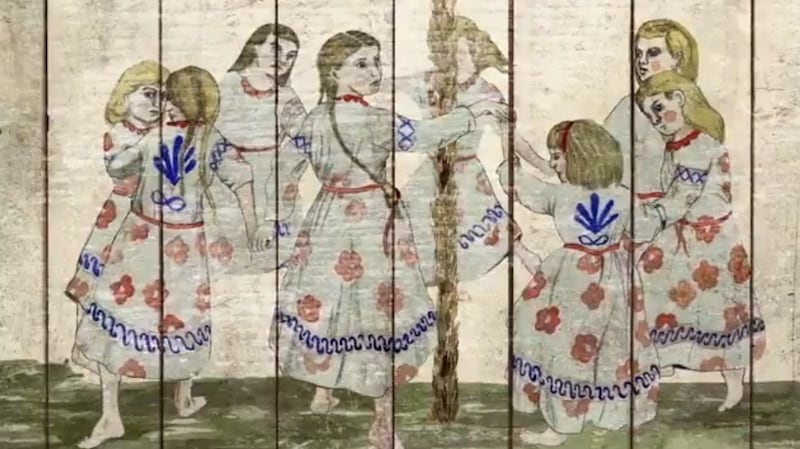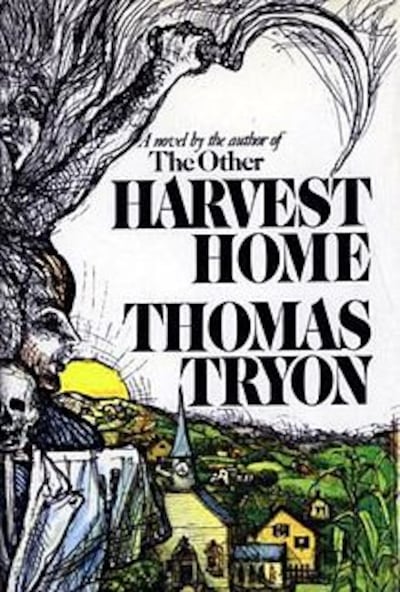The release of Ari Aster’s film Midsommar has brought renewed attention to a sub-genre which has gained considerable critical attention in recent years: so-called “folk horror”.
Three British films are generally considered key cinematic touchstones: Witchfinder General (1968), The Blood on Satan’s Claw (1971), and The Wicker Man (1973). Common folk horror characteristics include a rural setting, an emphasis on the eerie power of the natural landscape and a preoccupation with the sinister possibilities of the agrarian way of life. The primary narrative focus is often upon naïve, doomed outsiders. Ritualised human sacrifice is a common climactic trope, and is often connected to arcane rites intended to ensure the fertility of the crops.

Although much of the critical attention focused upon the sub-genre thus far has concentrated upon film and TV, folk horror also has a distinguished horror fiction lineage. Shirley Jackson’s The Lottery (1948) is arguably the most influential North American folk horror text. Set in a small town which, on June 27th every year, randomly selects one of its own to serve as a communal scapegoat, the story gains much of its power from the contrast between the entirely matter-of-fact way with which the lottery is carried out and the act of communal savagery it facilitates.
Jackson’s townsfolk don’t even remember why they need to carry out the ritual anymore. Nevertheless, the town’s oldest resident strongly rejects any suggestion that it be discontinued. “There’s always been a lottery,” he declares. Moments later, the local woman whose ballot has been drawn this time round is pitilessly stoned to death despite her cry that, “It isn’t fair, it isn’t right!”
The story caused considerable controversy when it debuted in the New Yorker, and Jackson received hundreds of angry letters. More disturbing still were the inquiries from people who believed that she was describing an actual New England custom, and, as she later put it, “wanted to know where these lotteries were held and whether they could go there and watch”.
Interestingly, although Midsommar is set in Sweden and draws upon Nordic folk beliefs, during one pivotal scene, the ritualised drawing of lots takes place, and enthusiastic communal participation in the film’s climactic “rite” is also a central part of the ceremony.
As in Jackson, small town horror is central to Stephen King’s 1976 story The Children of the Corn (which spawned a bizarrely fecund film franchise). The story begins as married couple Burt and Vicky find themselves dangerously side-tracked whilst driving through rural Nebraska. They become trapped in a town named Gatlin, where a terrifying outbreak of religious mania took place 12 years before.
Inspired by the ravings of their teenaged prophet, the town’s children murdered every adult in a single night. They are said to now live “alone under the eye of God… a God of corn, grown old and strange and hungry. He who walks behind the rows.” As is invariably the case within the folk horror tradition more generally, things do not end well for our tourists.
As Adam Scovell notes in his useful 2017 study Folk Horror: Hours Dreadful and Things Strange, in these kinds of narratives, places “supposedly of rest, exploration and holiday” are invariably seen as “almost alien in comparison to the everyday bustle of the urban”. American examples of the sub-genre also tend to dramatise the suspicion that the only thing more terrifying than a hillbilly with a chainsaw is a hillbilly with religion. These narratives are saturated with what horror film scholar Carol J Clover (1992) has memorably described as “urbanoia” (“urban paranoia”) rooted in the assumption that “people from the city are people like us […] People from the countryside are people not like us”.

Thomas Tryon was one of the leading lights of the early 1970s-horror publishing boom. His 1973 novel Harvest Home also contrasts a bucolic agricultural setting with arcane and appalling folk rituals. Ned Constantine, a go-getter from New York, decides to simplify life by moving his family to Cornwall Coombe, a New England village where the residents still hold fast to the pagan beliefs of their English ancestors.
We are told early on that, “Tradition… was the important thing here; tradition and custom, customs that had been preserved through the villager’s lineage since olden times…. What had been good for a man’s father and Grandfather was good enough for him; what they had worn, he wore; the tools they used, he used - a scythe to mow the hay, a sickle to cut the corn.”
Inevitably, Ned discovers that these beliefs extend to the enthusiastic perpetuation of fertility rites drawn straight from the gorier bits of Sir James Frazer’s pioneering study of ritual and religion, The Golden Bough (1890-1915). The novel is also notable for its anti-feminist paranoia: in Cornwall Coombe, the women are in charge, and Ned pays a heavy price for defying matriarchal edicts.
Another male New Yorker who deeply regrets leaving the city behind features in in TED Klein’s neglected classic The Ceremonies (1984). The main character here is an arrogant PhD student named Jeremy Feirs (he specialises in horror and gothic literature, which lends the novel a nicely meta touch: amongst other things, Jeremy at one point grumbles about Shirley Jackson’s supposed misanthropy). He impulsively rents a room on a farm in upstate New Jersey so that he can work on his thesis without distraction, and becomes fascinated by his landlords, a young couple belonging to the fundamentalist sect which dominates the community.
Yet again, the relationship between a naïve city dweller and religious farm folk does not end well, although Klein also incorporates a creepily effective supernatural plot element reminiscent of HP Lovecraft’s Cthulhu Mythos. Ken Greenhall’s excellent 1982 novel Childgrave (recently republished by Valancourt Books) traverses broadly similar ground to Klein and Tryon.
A much more recent horror novel, which, like Midsommar, depicts terrible things happening in (and because of…) broad daylight, is Gemma File’s Experimental Film (2016). The narrator is a Canadian film critic who unwisely begins to investigate the disappearance, almost a century before, of a wealthy widow whose pioneering but oddly disconcerting films turn out to be dangerously connected to the terrifying Middle-European folk legend of the savagely unforgiving Lady Midsummer.
The most prominent folk horror novel of recent years is, however, Andrew Michael Hurley’s The Loney (2016). It is a tale told in retrospect by a middle-aged man who recollects for us certain unsettling events which occurred during the 1970s, when his family and other members of their close-knit London Catholic community embarked upon an Easter pilgrimage to the bleakly beautiful Lancashire coastline. The Loney contains a deeply nuanced depiction of the relationship between Catholicism and pagan belief, and a memorable evocation of the eerie power of wild and lonely landscapes.
Like their cinematic counterparts, then, these literary excursions into the world of folk horror tend to underline for the reader both the wonder (and the terror) of landscapes which have yet to be tamed by urban or suburban development.
Furthermore, as in the (closely related) backwoods horror tradition, folk horror fiction of the American variety in particular tends to negatively depict characteristics associated with life in the countryside which would otherwise usually be considered positive. Here, the rural community's closeness to the land, rugged self-reliance, and determination to preserve tradition invariably elicits horror rather than admiration, and the most paranoid urbanite's worst suspicion about the kinds of activities "those kind of people" get up to when left to their own devices are violently, and vividly, vindicated.
Bernice M Murphy is lecturer in popular literature in the School of English, Trinity College Dublin. She has written several books on horror and gothic film and fiction, including The Rural Gothic in American Popular Culture: Backwoods Horror and Terror in the Wilderness (2013).











